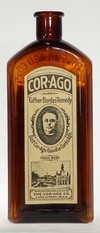27 Dec 2021, last updated 09 Nov 2025
The Cor-Ago Co. was a proprietary medicine company in Lake Linden based on Father Bordas' medical discovery.
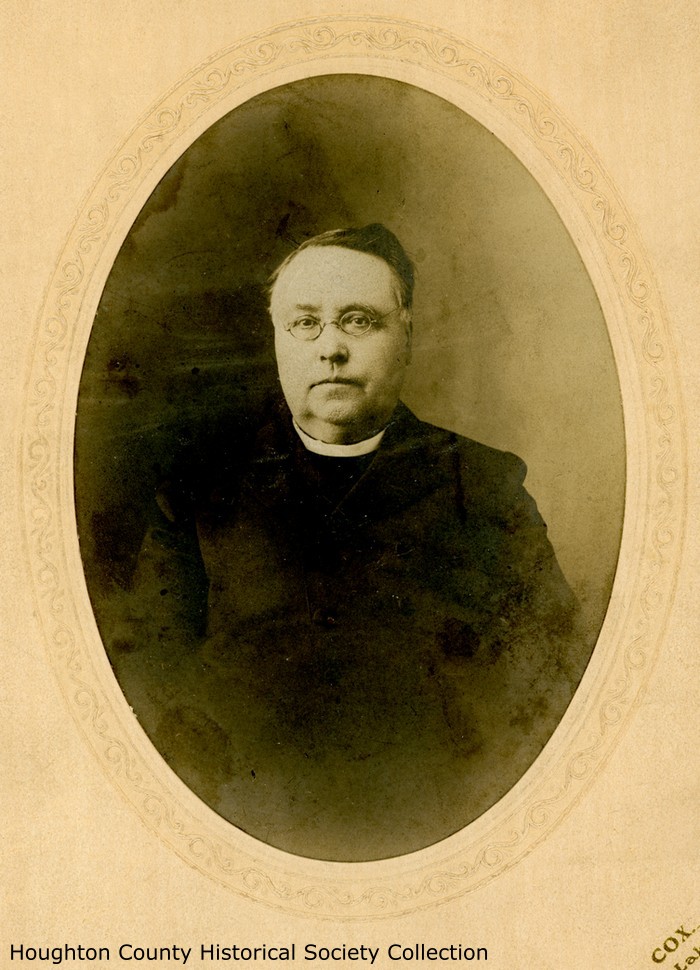
Father Bordas
Edonard P. Bordas was born in Limoges, France on 12 Oct 1943 (28,29) and was ordained in 1870 (29). He immigrated to the U.S. on 20 Jul 1879 (28) and was a priest for several churches in Northern Michigan (29). He became the priest of the St. Joseph church in Lake Linden on 22 May 1897 (29).
Bordas explained the history of his medicine (4):
My earliest recollections are associated with certain plants which were held in high esteem for their medicinal properties by the people among whom I passed my childhood and early manhood. Soon after being ordained as a priest of the Roman Catholic Church, I was transferred to the wilds of Northern Michigan. In those early days it frequently became necessary for me to combine the functions of a physician with my pastoral duties, it often being impossible to secure the services of a trained medical man. Under these circumstances, I provided myself with supplies of plants which I had learned to know so well in my native France, not being able to secure them in this country. It soon occurred to me (the expense of importation being so great) to attempt the propagation of the plant. To my unbounded surprise and pleasure I found that the climatic conditions and the peculiar soil of the wonderful copper country of Michigan were especially adapted to such propagation. The plants which I succeeded in raising were superior both as to size and as to quality to any which I had seen abroad.
He further explained how the demand for the medicine outgrew his ability to supply it (4). He imparted his formula and experience of nearly 50 years to a company of gentlemen who would manufacture the medicine for the benefit of the general public (4).
The Cor-Ago company was organized on 18 Jul 1903 by E. P. Bordas, Joseph Bosch, Geo. W. Orr, John E. Jones, N. Sarazin, and J. H. Wilson (3). The capital was $100,000 divided into 10,000 shares at $10 a share (2). Patents were secured in England and Canada and a trademark was registered for the U.S. (2).
In Aug 1903, the company purchased 20 acres to house the factory and to raise the plant (3). The company then purchased an additional piece of property in Sep 1903 (18). One acre was sown in Fall 1903 as an experiment (4), and then twenty acres were sown in Spring 1904 (11) over a period of several weeks with seeds imported from France (19).
By Apr 1904, local drug stores and other businesses were selling Cor-Ago (5,6). By May 1904, the company sold nearly 60 cases in Lake Linden and Hubbell and several cases in Hancock, Houghton, Laurium, and Calumet (7). Additional sales occurred in Ontonagon, Marquette, Delta, Menominee, and Schoolcraft counties (7). These early sales were produced from plants imported from France as they awaited their first crop grown in Lake Linden to mature (16).
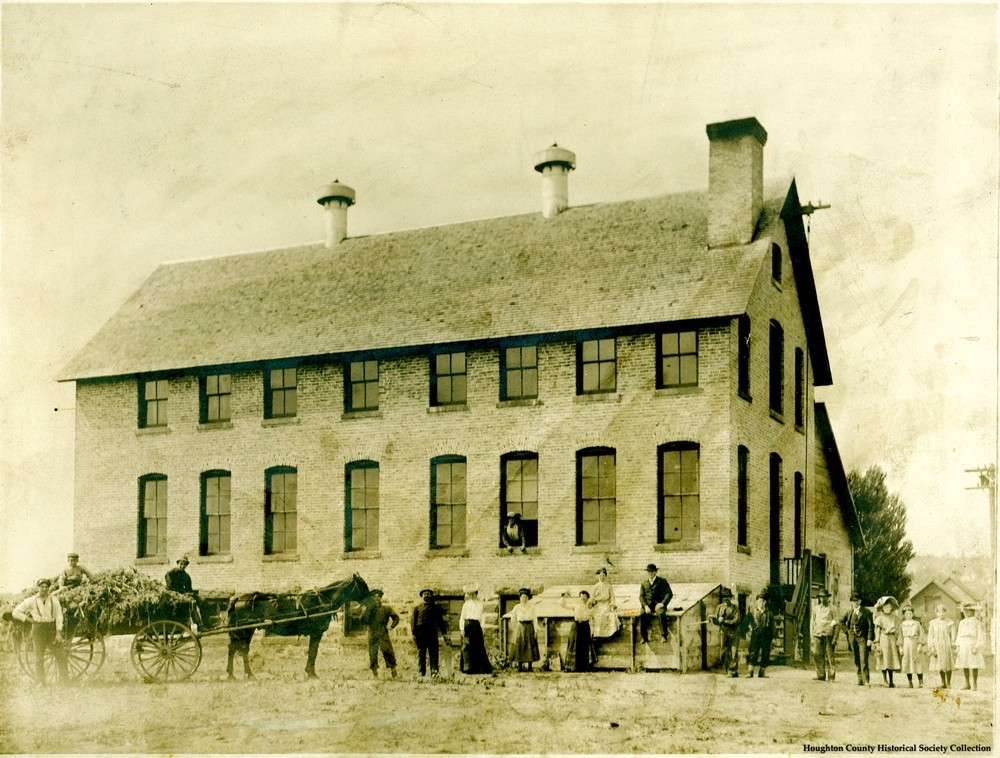
Cor-Ago building
By Aug 1904, the new factory building was nearly completed (8). It would be a two-story brick building with a stone basement (19). The first floor would house offices and the storage and evaporating rooms (19). The second floor would be used for drying and grinding the herb (19). The basement would hold the boiler for steam generation and the bottling operation (19). Maps show that the factory was located between Adelaine St. and Cor-Ago St., just north of 12th St. (1).
In Aug 1904, the first crop was in full bloom (8) and was being harvested (17). William Amundson, a chemist with 15 years of experience in Chicago, arrived in Sep 1904 and oversaw the preparation of Cor-Ago (9,15). In Sep 1904, the company was drying the plant daily in an air tight room heated to 160 degrees by a kiln (9). Sufficient supply to produce a few hundred thousand bottles was already stored away (9). The dried leaves would be pulverized into a powder and boiled in a 300-gallon copper caldron (19). The extract would then be filtered and concentrated by evaporation (19). The medicine was free of alcohol or anything that could be injurious to the body (20). The first batch of the company was bottled on 26 Sep 1904 (10). They expected to install a tableting machine within a few weeks and to start manufacturing Cor-Ago salve (10). Cor-Ago laxatives was expected to be on the market by about Feb 15 (12).
Cor-Ago was a "purely vegetable compound" (12). Advertising included with the medicine stated (1):
We desire it to be particularly understood that COR-AGO is not a "cure-all," that is, that it does not cure every ailment that flesh is heir to, from consumption to toothache. We do claim, however, that it is an alterative, having a special action on the liver, bowels, heart and kidneys, the equal of which has never before been placed in the hands of the public. An alterative is a remedy which, by its action on the purifying organs of the body, removes the products of decomposing waste, which are the cause of the great majority of diseases. In addition to its tonic alterative properties COR-AGO has a peculiar action on the heart.
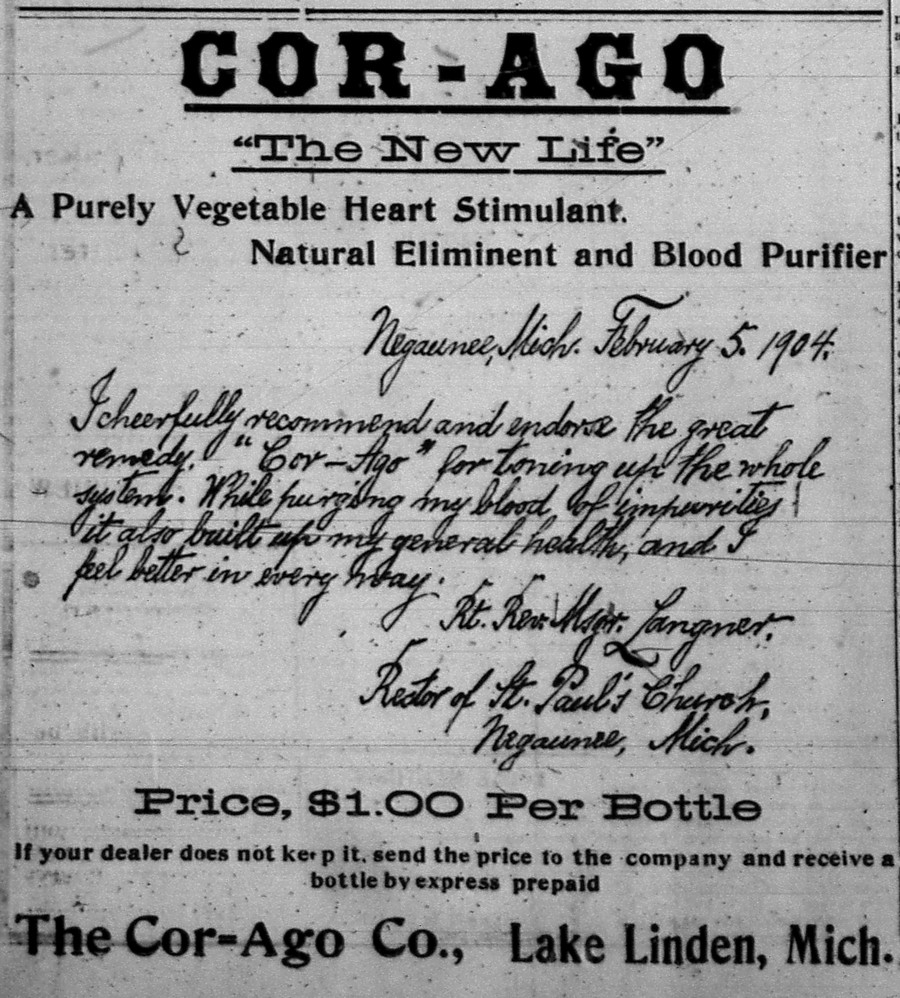
Newspaper ad - Apr 1904
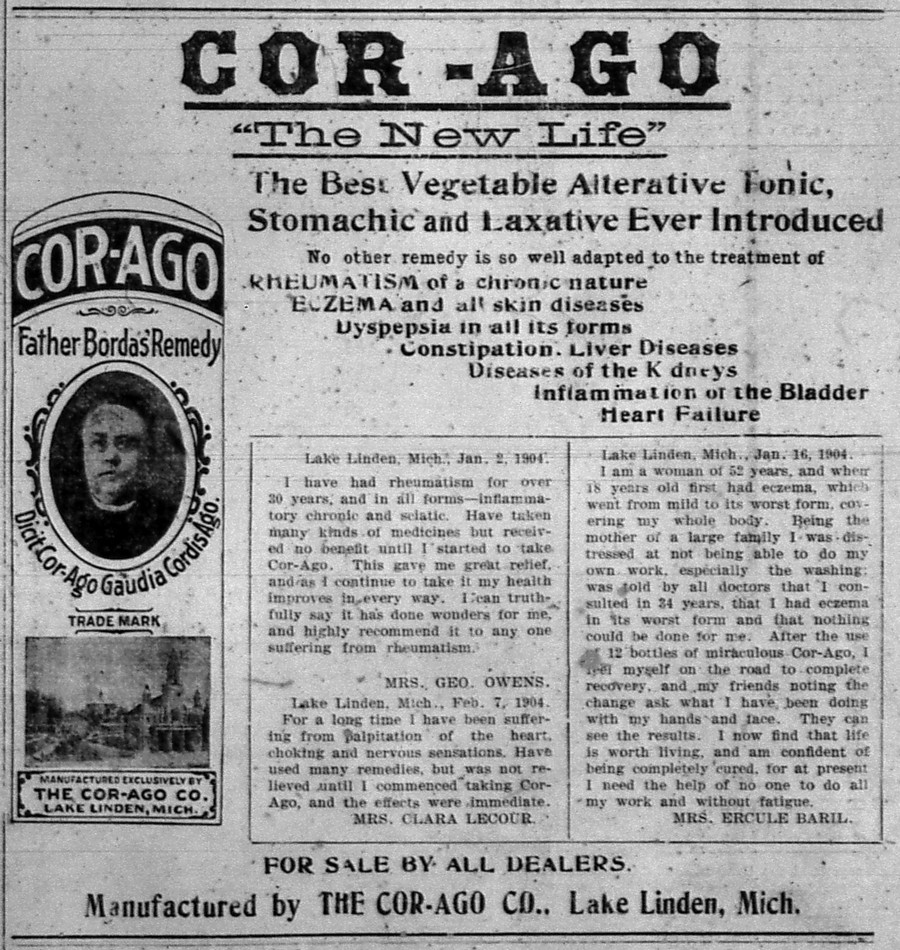
Newspaper ad - May 1904
The company received many testimonials of the curative effects of Cor-Ago (1,4). They received orders from as far away as New York and Boston in the east and several large cities in the west (15). An ad in The Copper Country Evening News, 06 Dec 1904, indicated that Cor-Ago was stocked by many local drug stores, including Sodergren & Sodergren, Laurium Pharmacy, Superior Pharmacy, Vastbinder & Read, Eagle Drug Store, Deschamps & Mogk, Geo. H. Nichols, Scott's Drug Store, Ed. C. DesRochers, F. W. Kroll, and Hubbell Pharmacy.
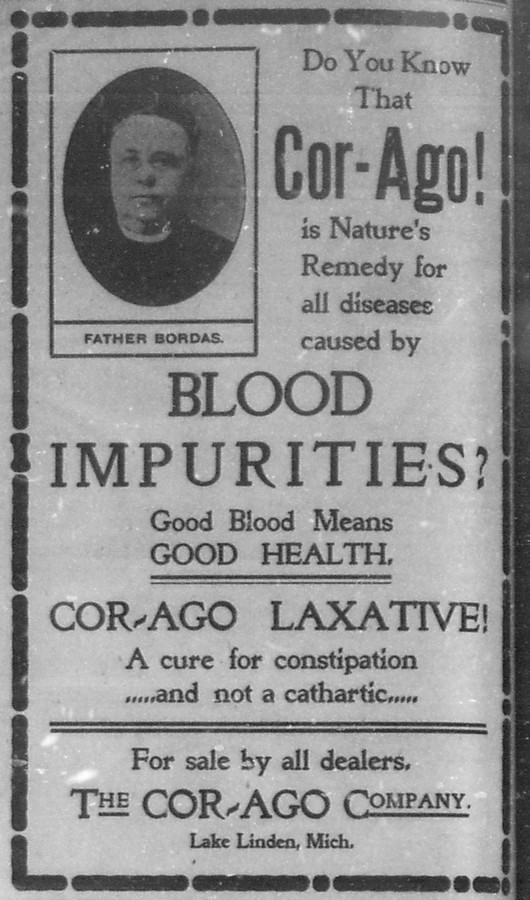
Newspaper ad - Mar 1905
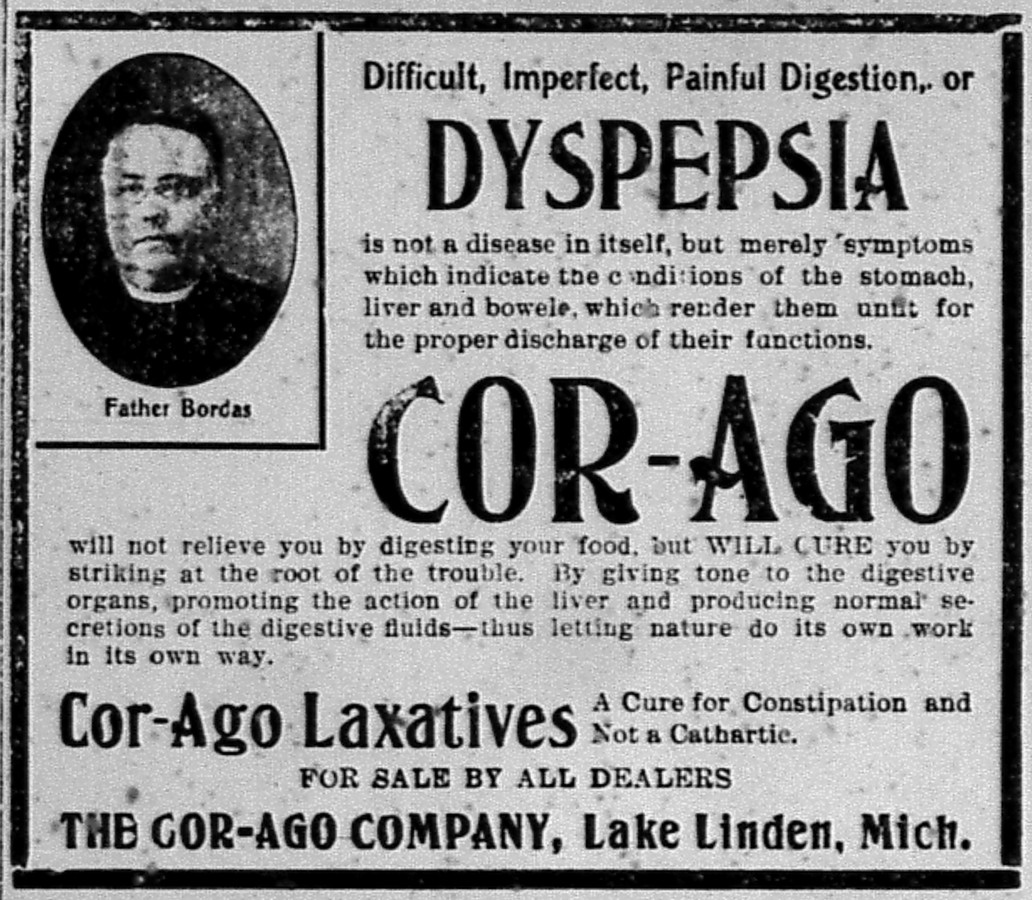
Newspaper ad - May 1905
The directors at their meeting in Feb 1905 decided to put a representative in the field to push the sale of Cor-ago (12). They appointed Charles A. Pearce as special agent for the company and he took sole control of the output and sale of Cor-ago (21). The newspaper reported that the company "had many obstacles to overcome, but with increasing sales which are now sufficient to meet all expenses, including advertising, the outlook for the future is most encouraging" (12). Pearce promptly pushed the sale of Cor-ago in Houghton and Baraga counties (22), and then went to Chicago on a business trip in late Apr (23). The newspapers then made no reports on the company for nearly a year and a half.
It turns out, for the first few months or so, the company flourished, but then business slacked and the factory closed (25). Bordas then called a meeting to be held on 14 Sep 1906 to discuss plans to pay off debt and resume operations (24). At the meeting, the shareholders were all in favor of resuming operations immediately, and they decided to sell more stock to raise money (26). They elected Rev. E. P. Bordas, who was now living in Ishpeming, as president, Thomas Parks as vice president, J. H. Wilson as secretary, and Laurent Jackques as treasurer; and they along with E. F. Prince served as the directors (26). They had enough of the plant raised and cured to manufacture thousands of dollars of the bottled medicine and the tablets, with the tablets being their latest product before closing (26). They also had about 14,000 bottles with enough labels and cartons (26). It was reported that the medicine had a good reputation and the company had over $3,000 in orders waiting to be fulfilled (26). The plan was the run the company "in a businesslike manner" in the future in contrast to the "slipshod sort of a manner" of the past (26).
It is unknown if the company actually resumed operations, especially in light of the next annual meeting, as reported on 02 Oct 1907 (27). They elected officers again: Rev. Fr. Bordas as president, D. W. Sutter as vice president, A. C. Sarazin as secretary, and Laurent Jacques as treasurer (27). The officers along with Thomas Parks and E. F. Prince served as directors (27). A considerable amount of the plant was still on hand (27). They decided to make another attempt of marketing their medicine in the near future, and felt that with economic management, the business would obtain better results (27). However, there was no evidence that they actually restarted the business.
Monette and Smith (1) presented a different account of the company's demise based to local recollections. When the company experienced a financial crisis, the board of directors released their chemist, William Amundson. The next batch made was a double batch, which spoiled in preparation and was bottled during the absence of Bordas. Many people got sick and the batch was recalled by the company and the Houghton County Public Health Department. Unfortunately, the damage to their reputation was fatal and the company dissolved in 1906. This account, however, was not mentioned in the newspapers from Lake Linden, Calumet, Hancock, and Houghton.
Bordas left the St. Joseph church in Lake Linden to become the priest of the St. Joseph church in Ishpeming, seemingly in Sep 1905 (29). He remained there until his death on 07 Jun 1915 (29) at the age of 71, and was buried in Ishpeming Cemetery (13).
For more information on Cor-Ago, see COR-AGO: A Lake Linden Medicine Company by Clarence J. Monette and G. Walton Smith (1).
Citations
- Monette, C. J. and G. W. Smith. 1974. COR-AGO: A Lake Linden Medicine Company. Greenlee Printing Co. Calumet, MI.
- anonymous. (1903, Jul 21). The Cor-Ago Company. The Native Copper Times (Lake Linden, MI). p. 1.
- anonymous. (1903, Sep 01). The Cor-Ago Company. The Native Copper Times (Lake Linden, MI). p. 1.
- anonymous. (1904, Mar 29). "COR-AGO". The Native Copper Times (Lake Linden, MI). p. 1.
- anonymous. (1904, Apr 05). untitled. The Native Copper Times (Lake Linden, MI). p. 1.
- anonymous. (1904, Apr 26). untitled. The Native Copper Times (Lake Linden, MI). p. 1.
- anonymous. (1904, May 10). The Cor-Ago Company. The Native Copper Times (Lake Linden, MI). p. 1.
- anonymous. (1904, Aug 09). untitled. The Native Copper Times (Lake Linden, MI). p. 1.
- anonymous. (1904, Sep 20). The Cor-Ago Company. The Native Copper Times (Lake Linden, MI). p. 1.
- anonymous. (1904, Sep 27). Commenced bottling Monday. The Native Copper Times (Lake Linden, MI). p. 1.
- anonymous. (1904, Nov 15). Where Cor-Ago is prepared. The Native Copper Times (Lake Linden, MI). p. 1.
- anonymous. (1905, Feb 14). COR-AGO. The Native Copper Times (Lake Linden, MI). p. 1.
- Find a Grave. accessed Jul 2022. Rev Fr Edward Peter Bordas. www.findagrave.com/memorial/98376625/edward-peter-bordas
- anonymous. (1903, Aug 04). New stock company. The Copper Country Evening News (Calumet, MI). p. 3.
- anonymous. (1904, Sep 15). Cor-Ago success. The Copper Country Evening News (Calumet, MI). p. 6.
- anonymous. (1904, Sep 17). Cor-Ago home-grown here. The Copper Country Evening News (Calumet, MI). p. 6.
- anonymous. (1904, Aug 12). Gathering crop. The Evening Journal (Hancock, MI). p. 7.
- anonymous. (1903, Sep 14). Lake Linden brevities. Hancock Evening Journal (Hancock, MI). p. 7.
- anonymous. (1904, Jul 06). First crop of Cor-Ago plant. The Daily Mining Gazette (Houghton, MI). p. 7.
- anonymous. (1904, Sep 15). Cor-Ago plant will expand. The Daily Mining Gazette (Houghton, MI). p. 7.
- anonymous. (1905, Feb 11). Appointed sole agent. The Copper Country Evening News (Calumet, MI). p. 5.
- anonymous. (1905, Feb 17). Lake Linden briefs. The Copper Country Evening News (Calumet, MI). p. 4.
- anonymous. (1905, Apr 27). Lake Linden. The Copper Country Evening News (Calumet, MI). p. 5.
- anonymous. (1906, Aug 29). Cor-Ago company may resume its operations. The Copper Country Evening News (Calumet, MI). p. 2.
- anonymous. (1906, Sep 13). Meeting called. The Evening Journal (Hancock, MI). p. 7.
- anonymous. (1906, Sep 15). Operations to be resumed. The Daily Mining Gazette (Houghton, MI). p. 5.
- anonymous. (1907, Oct 02). Will try once more. The Daily Mining Gazette (Houghton, MI). p. 7.
- United States, Passport Applications, 1795-1925. FamilySearch (https://www.familysearch.org/ark:/61903/1:1:QV5Y-G3K9 : Fri Apr 25 03:30:21 UTC 2025), Entry for Peter Edward Bordas, 1910.
- anonymous. (1915, Jun 08). Death of Father Bordas. The Native Copper Times (Lake Linden, MI). p. 1.
color: amber
top: cork seal
maker's mark: (none)
other marks: COR-AGO (both sides)
date: 1904-1906
rarity: extremely rare


